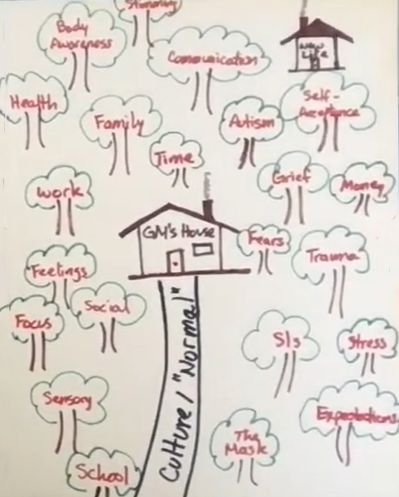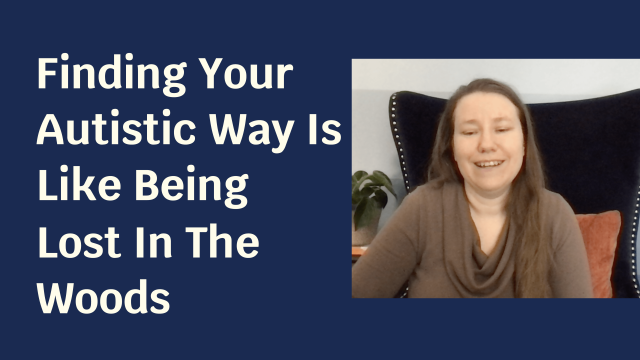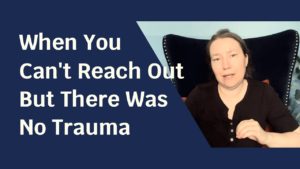
What does an autism-friendly life look like?
I’d like to share something with you today that clicked for me recently. So, I am a certified coach and I work with a lot of autistic people, like myself, who have gotten to a point where they’re sick of trying to be normal and they want to make a better life that works for them, for their brain, their body, and their sensory needs. But they’re not quite sure how to do that. So I help them figure that out.
It’s the things that we’re told to do, how we’re supposed to behave, what we should do and shouldn’t, all those things.
I often hear my clients express to me this feeling of being lost, of being adrift, or drowning, or whatnot, and they don’t really know where to go from where they are. They have an idea that things could be better, but they don’t know how that’s possible, and how to make that happen. And that’s, by the way, what I help them with. But what clicked for me a few days ago was that this experience is very much like the story of Little Red Riding Hood.
In the story of Little Red Riding Hood, she is told to stay on the path. Not to stray right or left, but to stay on the path and it would take her to grandma’s house. And that’s all the messages that society gives us. It’s the things that we’re told to do, how we’re supposed to behave, what we should do and shouldn’t, all those things. And we try as we go through our life to do that as much as possible.
Now it doesn’t always work, sometimes we stray from the path a little bit, maybe go pick some flowers, but we come back and we put a lot of effort into trying to stay on the path. Doing the things that we’re supposed to do, that we’re told to do, like being normal.
In the process you have this cloak on, she wears a red cloak or hood, think of this as the autism mask that helps her feel safe. It’s trying to look like others, trying to pretend to be others, but mostly it helps her feel safe, to feel like she’s going to be protected along this scary, dangerous road. And if you stay on this road long enough, this path in the woods of society’s expectations, it’ll take you to grandmother’s house. And when she gets there, she sees this wolf that’s dressed like her grandmother, it’s clearly not but she doesn’t trust herself.
Leading to danger
She thinks that there’s something wrong here, and I think that really deep down she knows this is not her grandmother, but she’s being told that this is what is supposed to be right. She’s so used to believing people, and believing everything that people tell her is true, that even when she questions it (and that’s the closest she could get to actual defiance, just questioning, “Are you sure this is your grandmother but your mouth is so big, but your eyes are so big?”), she accepts the wolf’s answer. “Oh, it’s just this, it’s just that.” “It’s better to see you by, better to smell you.”
And so she accepts the answer, even though she doesn’t really believe it. She wants it to be. She wants to feel safe. She wants to know that what she’s been told is true, but it gets her into trouble.
And so she accepts the answer, even though she doesn’t really believe it. She wants it to be. She wants to feel safe.
Here’s the interesting part, there’s actually a few different versions of the story. In the original Grimm’s Brothers, she gets gobbled up by the wolf, then the Hunter comes along, cuts the wolf’s belly open, and she and the grandmother crawl out of it. Breathing. I’ve never quite figured that part out. But later than the Grimm’s, she cut herself out of the wolf. In modern American versions, it’s less graphic. They run around in the cabin, that wolf chases her and she gets away.
Anyway, that’s actually part of my point though, that there are different versions of this. We all go through different experiences. For some people, it’s burnout. That was for me, it was an extreme burn out after I couldn’t do this game any longer. I couldn’t play the good little girl who is like everyone else. It didn’t work after a while and my body physically shut down. For some people, it’s just reaching a point where they know instinctively that they can’t do it anymore or they don’t want to live like this anymore.
There’s a wide variety of reactions, of people coming to this place of wanting to change something for the better, who’re coming from a variety of different places. But it’s still this need, this instinctive need to do something, to really live your own life. So she gets out of the house, she escapes. But then she’s lost in the woods, there’s no clear path. The path that brought her there is not the path of life, that’s the path to death. That’s the path to the grandmother’s house, to danger.
Forging a new path
So she’s trying to find some… and here I’m taking liberties with the story. It doesn’t really go like this but, for me, I was trying to find my new way. It took me a long ways, but this is the place where I meet a lot of my clients. It’s that they’ve gotten to the point where they know something has to change, but they’re not sure how to do that, how to make it better, and you have all of these different scary things around you. So you’re lost in this deep dark woods, there’s looming trees with shadows, there’s sounds of wolves in the distance howling, there’s maybe an owl hooting, and it freaks you out.
So you’re lost in this deep dark woods, there’s looming trees with shadows, there’s sounds of wolves in the distance howling, there’s maybe an owl hooting, and it freaks you out.
All of these different things that are trying to vie for your attention, to make you do things their way. Occasionally, you might even get to see glimpses of different paths, and some of them might be useful for a while, but they don’t really end up where you want. Some of them are terrible paths, but you try a variety of different things. And all of these things, all the different trees and animals in the woods, and all the different dangers, I see them as the different things that we have to contend with in our lives.
Like our sensory needs, different ways of socializing, communicating, money, time, if you have family pressures or expectations, you need to take care of your kids, your parents, people are telling you to do things, you have a school telling you what to do, you need a job, you need to keep your job, the way that you focus, the way that you process experiences, your feelings, or traumas from your past.
All sorts of different things, and the goal here in this lost in the woods experience is not to stay in the woods, but you do have to contend with the different things at different levels. Some are brief, some are long, some take a while to figure them out, but you have to learn new ways of relating to each of these things.
I’m imagining how Little Red Riding Hood’s cloak at this point is not gone, but it’s in tatters. Like there’s tears in it from the fight with the wolf, and sometimes that protects her, and sometimes it doesn’t. Sometimes she can still pull up the hood and feel invisible, but sometimes there’s tears in it that she peeks through and people can see bits of who she really is. And that’s kind of scary, but also maybe kind of interesting.
Finding your home
So the goal here is, like I said, not to stay lost in the woods, but to contend with the different things to create your own path. It’s to forge a path that works for you. There isn’t a clear cut route that society has made, you’ve already tried that one and it didn’t work, so you have to make your own one that works for you. The goal here is to reach a new place, a safe house, maybe you can find a cabin in the woods, maybe you can build one. Maybe it’s on the edge of the forest, maybe it’s in the next city, or maybe it’s deep in the forest.
There isn’t a clear cut route that society has made, you’ve already tried that one and it didn’t work, so you have to make your own one that works for you.
If you really genuinely want the hermit lifestyle, maybe it’s finding a new town or village to set up camp, but you’ll need to find a new house, a new place where you feel safe. It doesn’t have to be necessarily a literal place, but a metaphorical new lifestyle.
Essentially a life that really works for you. It’s not a static thing either. That new place is going to change and adapt as you change and adapt, because we all do that over the course of our lives. No one remains static, but you’ll have the skills at that point to know how to do it, how to find your way, and how to navigate the different things as they come up.

So I made this little diagram, please excuse my drawing skills, but these are some of the things that I see as the dangers in the forest. Some of them are good things, some of them are dangerous. Some of them could be either depending on how you react to it, depending on how you relate to it or depending on different times in your life, different times in your journey.




